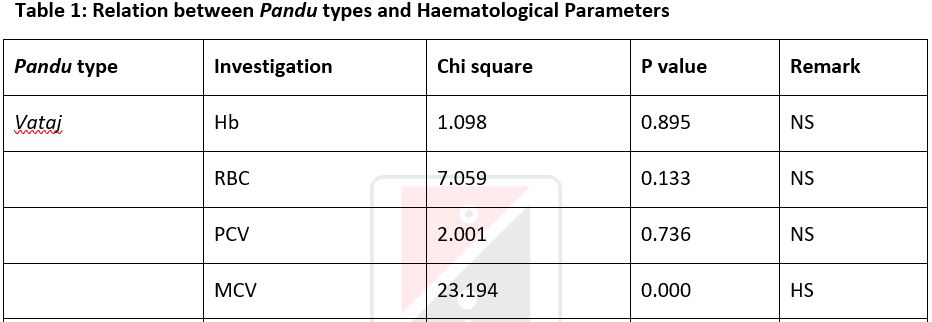Understanding types of Pandu Roga on the basis of common Haematological Parameters - A Comparative Study
DOI:
https://doi.org/10.21760/jaims.10.2.10Keywords:
Pandu, Ranjana, Ayurveda, Rasa, Pitta, KetkiAbstract
Considering human lifestyles and routines, the 21st century is unlike any earlier century. People experience a tremendous amount of stress and strain in their day today life, which has a detrimental impact on their quality of life. Additionally, in present time, people tend to eat Viruddha Aahar like pizzas, Chinese food, pickle, packed edibles, gupchup, burgers, chips etc. which are Kshara Rasa Pradhan. It has been noted that in India, not only lower economic group, middle as well as higher economic group also suffer from Pandu Roga under different circumstances. Pandu is a Pitta Pradhana disease, which ultimately affects all Dhaatus, especially Rasa Dhaatu, and prevents Rasa from going through the Ranjana or pigmentation process. There is a need to differentiate different types of Pandu with haematological parameters. This will be helpful for Ayurvedic Physicians and students as the line of treatment is different for every type of Pandu Roga in Ayurveda Classics. Here in this article an attempt has been made to differentiate types of Pandu with the help of Haematological parameters.
Downloads
References
Agnivesha. Charaka Samhita. Edited with “Charaka Chandrika” Hindi Commentary by Dr. Brahmanand Tripathi. 2013 ed. Varanasi: Chaukhamba Surbharti Prakashan; Sutra Sthana Adhyaya 28/9-10. p. 548.
Sushruta. Sushruta Samhita of Maharshi Sushruta. Edited with Ayurveda-Tattva-Sandipika by Kaviraja Ambikadutta Shastri. Part 1. 2012 ed. Varanasi: Chaukhamba Sanskrit Sansthan; Sutra Sthana Adhyaya 15/3. p. 73.
Bhattacharya TT. Vachaspatyam. Part 5. 1962 ed. Varanasi: Chaukhambha Sanskrit Series Office.
Park K. Park’s Textbook of Preventive and Social Medicine. 25th ed. Pune: M/s Banarasidas Bhanot Publishers; 2019. Nutritional Problems in Public Health. p. 593.
Central Council for Research in Ayurveda and Siddha. Clinical Research Protocols for Traditional Health Sciences. New Delhi: Department of AYUSH, Ministry of Health and Family Welfare, Government of India; p. 837.
Agnivesha. Charaka Samhita. Edited with “Vadyamanorama” Hindi Commentary by Acharya Vidyadhar Shukla, Prof. Ravi Dutt Tripathi. 2013 ed. Varanasi: Chaukhamba Sanskrit Pratishthan; Chikitsa Sthana Adhyaya 16/7-9. p. 396.
Agnivesha. Charaka Samhita. Edited with “Vadyamanorama” Hindi Commentary by Acharya Vidyadhar Shukla, Prof. Ravi Dutt Tripathi. 2013 ed. Varanasi: Chaukhamba Sanskrit Pratishthan; Chikitsa Sthana Adhyaya 16/7-9. p. 397.
Agnivesha. Charaka Samhita. Edited with “Charaka Chandrika” Hindi Commentary by Dr. Brahmanand Tripathi. 2013 ed. Varanasi: Chaukhamba Surbharti Prakashan; Sutra Sthana Adhyaya 1/59. p. 32.
Agnivesha. Charaka Samhita. Edited with “Charaka Chandrika” Hindi Commentary by Dr. Brahmanand Tripathi. 2013 ed. Varanasi: Chaukhamba Surbharti Prakashan; Sutra Sthana Adhyaya 1/60. p. 32.
Agnivesha. Charaka Samhita. Edited with “Charaka Chandrika” Hindi Commentary by Dr. Brahmanand Tripathi. 2013 ed. Varanasi: Chaukhamba Surbharti Prakashan; Sutra Sthana Adhyaya 1/61. p. 33.















